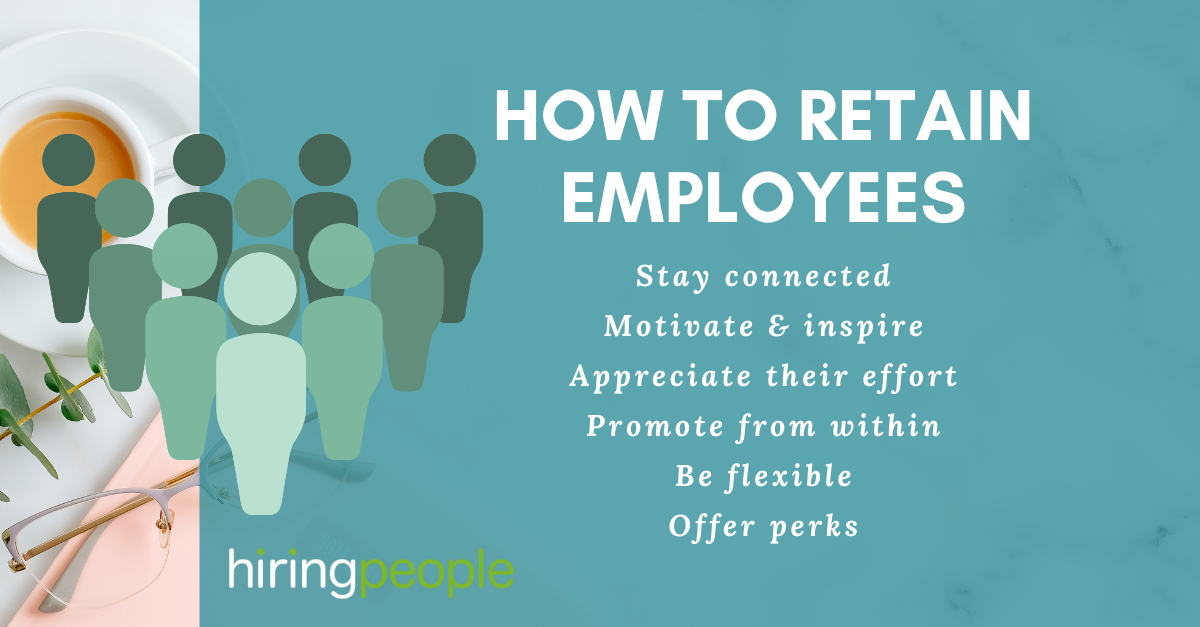How To Retain Employees

You’ve placed the job advertisements, you’ve looked through perhaps hundreds of CVs and you’ve interviewed a number of candidates for your vacancy. Finally, you’ve found exactly the right person for the position. Job done, right? Wrong. Actually, the hard work starts now and that’s because, having done all of that work (and spent all of that money) recruiting your new employee, you want to make sure they stay with you.
Discover how to interview candidates for your role here.
A high staff turnover of staff costs businesses, both in terms of time and in productivity. It is far better therefore to have in place an employee retention programme which will provide both new recruits and long-term employees with good reasons not just to stay with your company but to remain motivated and driven. This in turn will benefit your business enormously.
Read: The Pros And Cons Of High Staff Turnover.
Here at Hiring People, we have put together a list of our top 7 employee retention tactics that you might consider implementing:
1. Regular Communication
Regular communication is absolutely key and if you only make one change, make sure it’s improving communication channels with your staff. Tell them how they’re doing in regular feedback sessions. As well as an opportunity to highlight areas of their work that may require improvement, it’s a chance to tell your employees what they are doing right and how their work contributes to the overall success of the company. Employees will feel empowered with this information (both the good and bad points) and it will make them feel in control of their own development. Irregular feedback, or worse no feedback, will make employees feel direction-less and unmotivated.
2. Line Managers/Supervisors
Line Managers / Supervisors must be involved in the above process and their ability to motivate the staff around them should not be underestimated. Employees often leave an organisation because of their Line Manager or Supervisor, rather than because of the organisation itself. If Line Managers adopt an ‘open door policy’ with the employees they are responsible for, employees will feel they can talk through any issues and get them resolved quickly and effectively, rather than allowing problems to fester until they become enormous. Knowing what is expected of them and how well they are meeting those expectations will keep employee morale high.
It should also be the job of a Line Manager to communicate the ‘vision’ of the business. Knowing what their company’s goals and aims are in the coming months will help employees feel connected to the main thrust of the business. Keeping employees emotionally connected is a big part of effectively retaining employees.
3. Consider An HR Manager?
Consider employing an HR Manager if your company has around 100 employees. Hiring, managing and retaining employees is a complex, time-consuming process and knowing that someone is consistently on top of that side of the business will mean that the energy of others can more constructively be used elsewhere in the business. More importantly, employees will also feel they have a dedicated person to go to with any problems or issues. An HR professional will ensure employees are treated fairly, that employment laws are being adhered to and they will also oversee everything employee-related, from employee benefits and reviews to the finer detail of holidays etc.
4. Promote
Wherever possible, promote from within the company. If employees know they have a clear career path with your company and see their colleagues being promoted, they will be incentivised to remain with you and work hard. Remember that as much as it is a hassle for you to hire a new employee, it’s also a hassle for an employee to move to a new company. If employees can see that their hard work will pay off, they will stick with you.
Read: A Guide On How To Hire.
5. Employee Development
Foster employee development – be it enabling your employees to learn a new skill on the job or providing the opportunity for them to attend external training courses, this will both motivate and inspire your employees and prevent them ‘going stale’ in their position.
6. Exit Interviews
Ensure you always conduct exit interviews. This is the clearest indicator of where you are falling down on employee retention. Listen to what is being said and act upon your findings. Don’t assume that an employee who is leaving will be disgruntled and therefore not worth listening to. Very often, what they tell you is enormously enlightening and will provide you with a starting point to improve your employee retention programme. If you are losing a valued employee, we recommend reading What To Do When A Key Employee Hands In Their Resignation Letter.
7. Benefits Package
Where possible, offer a competitive benefits package. This could cover health insurance, life insurance, pension provision, sick leave, childcare and holiday (paid and non-paid). The whole purpose of employee benefits is to increase the economic security of employees and consequently improve employee retention. Other benefits of a more discretionary nature might include car allowance, allowances for lunch, leisure activities during work time, free refreshments etc. Some of these may seem insignificant but can really incentivise staff and make them think twice about looking for a new position in another organisation.



